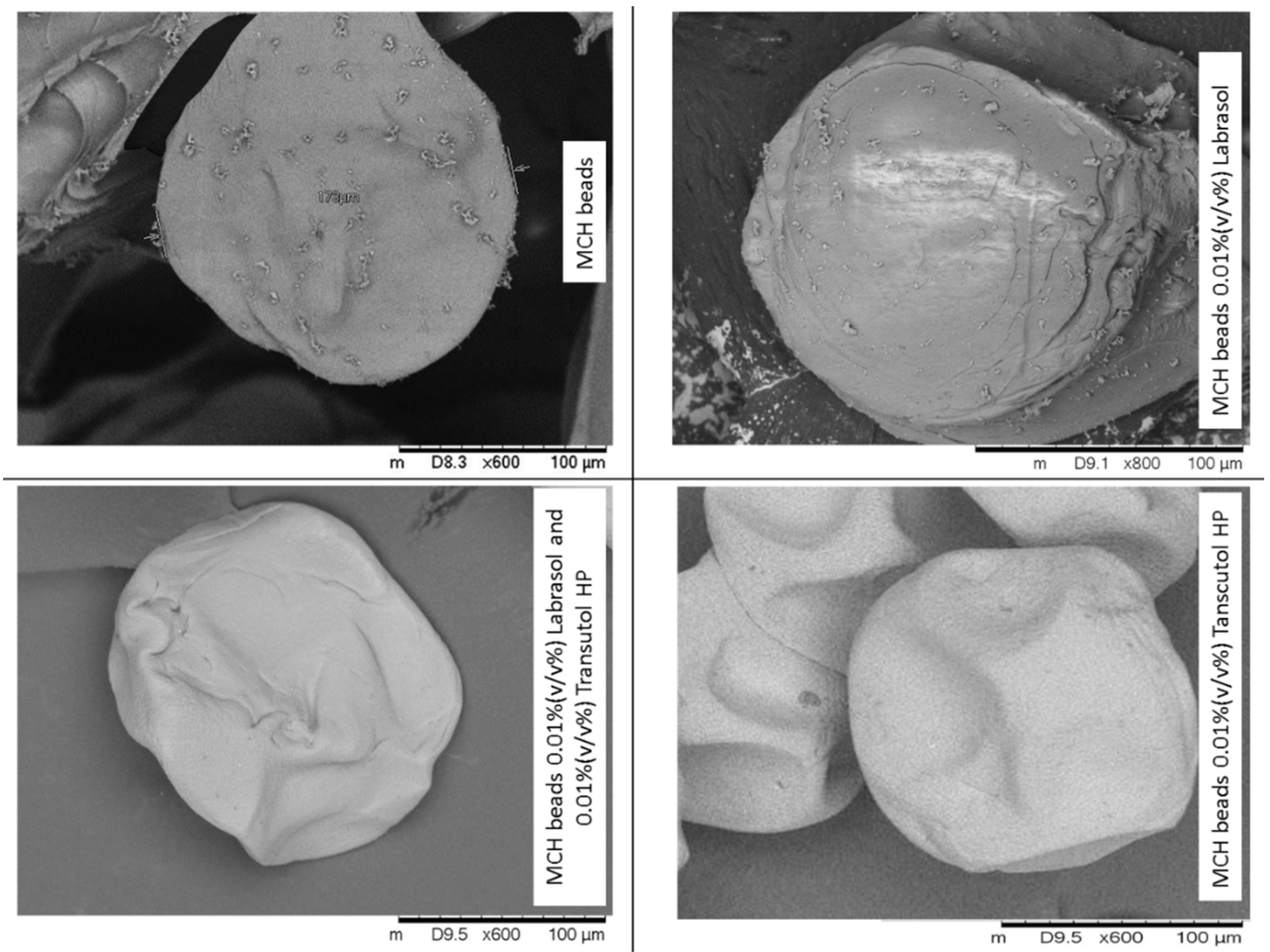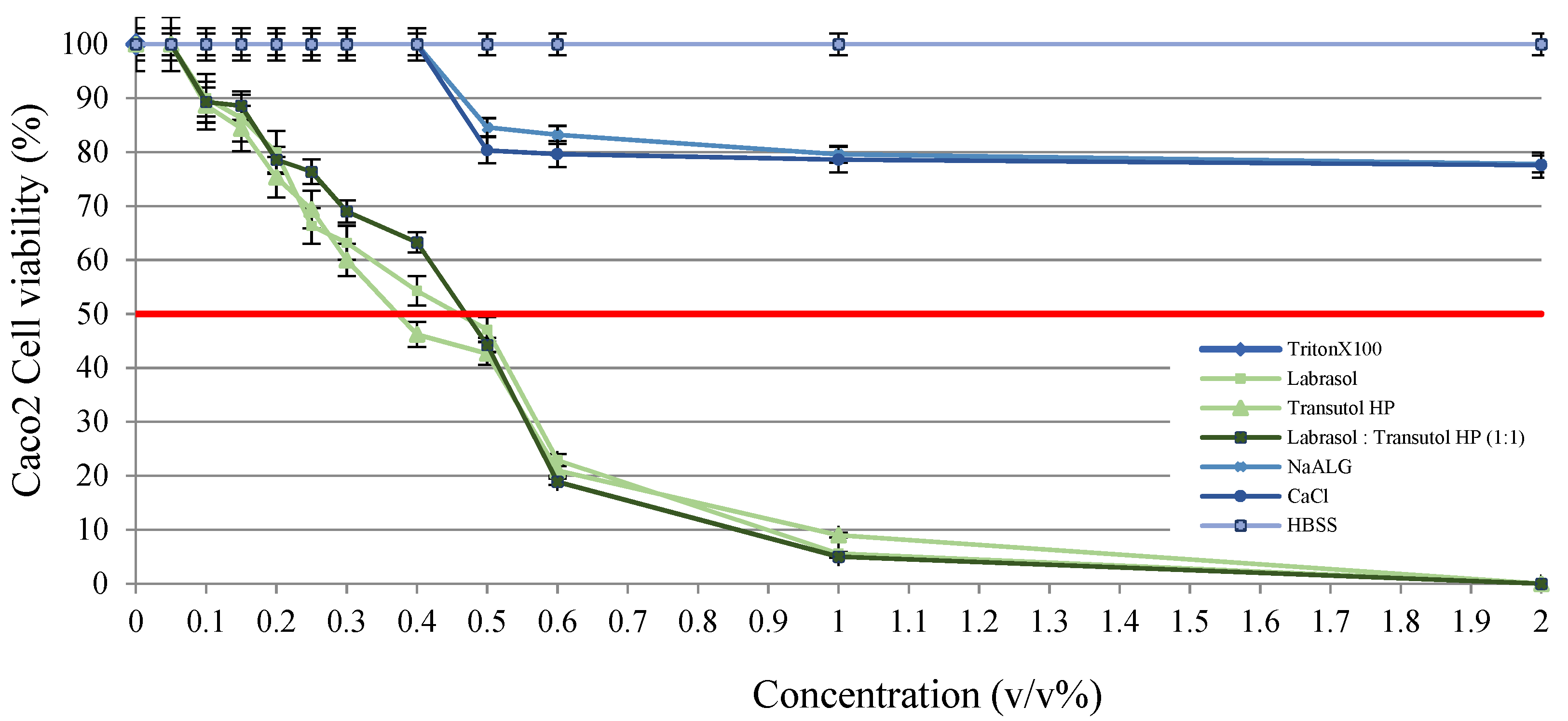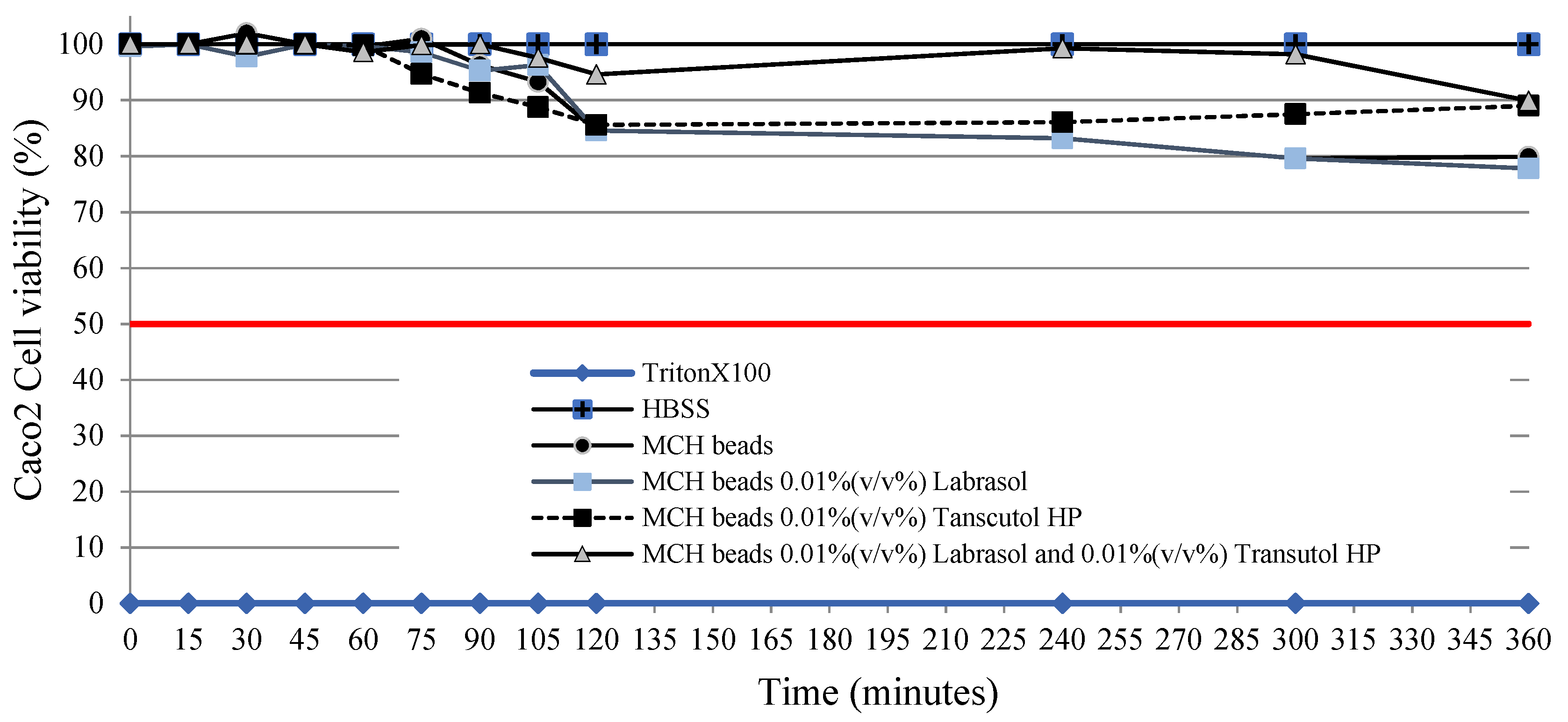Oral Bioavailability Enhancement of Melanin Concentrating Hormone, Development and In Vitro Pharmaceutical Assessment of Novel Delivery Systems
Abstract
:1. Introduction
2. Materials and Methods
2.1. Materials
2.2. Methods
2.2.1. Preparation of Sodium-Alginate and CaCl2 Solutions
2.2.2. Preparation of Peptide-Loaded Alginate Beads
2.2.3. Encapsulation Efficiency
2.2.4. Study of Swelling Behavior
2.2.5. Scanning Electron Microscopy
2.2.6. Particle Size Distribution
2.2.7. In Vitro Dissolution
2.2.8. Enzymatic Stability
2.2.9. Cell Culturing
2.2.10. Cell Viability Assay
2.2.11. Permeability Test
2.2.12. Transepithelial Electrical Resistance Measurements
2.2.13. Statistical Analysis
3. Results
3.1. Formulated MCH Beads
3.2. Encapsulation Efficiency
3.3. Study of Swelling Behavior
3.4. Scanning Electron Microscopy
3.5. Particle Size Distribution
3.6. In Vitro Dissolution
3.7. Enzymatic Stability
3.8. MTT Viability Assay
3.9. Permeability Test
3.10. Transepithelial Electrical Resistance Measurements
4. Discussion
5. Conclusions
Author Contributions
Funding
Conflicts of Interest
References
- Deb, P.K.; Al-Attraqchi, O.; Chandrasekaran, B.; Paradkar, A.; Tekade, R.K. Protein/Peptide Drug Delivery Systems. In Basic Fundamentals of Drug Delivery; Elsevier: Amsterdam, The Netherlands, 2019; pp. 651–684. ISBN 9780128179093. [Google Scholar]
- Brayden, D.J.; Mrsny, R.J. Oral peptide delivery: Prioritizing the leading technologies. Ther. Deliv. 2011, 2, 1567–1573. [Google Scholar] [CrossRef]
- Shaji, J.; Patole, V. Protein and peptide drug delivery: Oral approaches. Indian J. Pharm. Sci. 2008, 70, 269. [Google Scholar] [CrossRef] [Green Version]
- Mahato, R.I.; Narang, A.S.; Thoma, L.; Miller, D.D. Emerging Trends in Oral Delivery of Peptide and Protein Drugs. Crit. Rev. Ther. Drug Carrier Syst. 2003, 20, 153–214. [Google Scholar] [CrossRef]
- Aungst, B.J.; Saitoh, H.; Burcham, D.L.; Huang, S.-M.; Mousa, S.A.; Hussain, M.A. Enhancement of the intestinal absorption of peptides and nonpeptides. J. Control. Release 1996, 41, 19–31. [Google Scholar] [CrossRef]
- Bruno, B.J.; Miller, G.D.; Lim, C.S. Basics and recent advances in peptide and protein drug delivery. Ther. Deliv. 2013, 4, 1443–1467. [Google Scholar] [CrossRef] [Green Version]
- Brayden, D.J.; Hill, T.A.; Fairlie, D.P.; Maher, S.; Mrsny, R.J. Systemic delivery of peptides by the oral route: Formulation and medicinal chemistry approaches. Adv. Drug Deliv. Rev. 2020, 157, 2–36. [Google Scholar] [CrossRef]
- Anderson, S.L.; Beutel, T.R.; Trujillo, J.M. Oral semaglutide in type 2 diabetes. J. Diabetes Complicat. 2020, 34, 107520. [Google Scholar] [CrossRef] [PubMed]
- Ways, T.M.; Lau, W.; Khutoryanskiy, V. Chitosan and Its Derivatives for Application in Mucoadhesive Drug Delivery Systems. Polymers 2018, 10, 267. [Google Scholar] [CrossRef] [PubMed] [Green Version]
- Greimel, A.; Werle, M.; Bernkop-Schnürch, A. Oral peptide delivery: In-vitro evaluation of thiolated alginate/poly (acrylic acid) microparticles. J. Pharm. Pharmacol. 2010, 59, 1191–1198. [Google Scholar] [CrossRef]
- Coppi, G.; Iannuccelli, V.; Leo, E.; Bernabei, M.T.; Cameroni, R. Chitosan-Alginate Microparticles as a Protein Carrier. Drug Dev. Ind. Pharm. 2001, 27, 393–400. [Google Scholar] [CrossRef]
- Banerjee, A.; Lee, J.; Mitragotri, S. Intestinal mucoadhesive devices for oral delivery of insulin. Bioeng. Transl. Med. 2016, 1, 338–346. [Google Scholar] [CrossRef]
- Park, C.G.; Huh, B.K.; Kim, S.-N.; Lee, S.H.; Hong, H.R.; Choy, Y. Bin Nanostructured mucoadhesive microparticles to enhance oral drug bioavailability. J. Ind. Eng. Chem. 2017, 54, 262–269. [Google Scholar] [CrossRef]
- Arnaldi, P.; Pastorino, L.; Monticelli, O. On an effective approach to improve the properties and the drug release of chitosan-based microparticles. Int. J. Biol. Macromol. 2020, 163, 393–401. [Google Scholar] [CrossRef] [PubMed]
- Gupta, V.; Hwang, B.-H.; Doshi, N.; Banerjee, A.; Anselmo, A.C.; Mitragotri, S. Delivery of Exenatide and Insulin Using Mucoadhesive Intestinal Devices. Ann. Biomed. Eng. 2016, 44, 1993–2007. [Google Scholar] [CrossRef]
- Yu, L.; Sun, Q.; Hui, Y.; Seth, A.; Petrovsky, N.; Zhao, C.-X. Microfluidic formation of core-shell alginate microparticles for protein encapsulation and controlled release. J. Colloid Interface Sci. 2019, 539, 497–503. [Google Scholar] [CrossRef] [PubMed] [Green Version]
- Zhang, Y.; Wei, W.; Lv, P.; Wang, L.; Ma, G. Preparation and evaluation of alginate–chitosan microspheres for oral delivery of insulin. Eur. J. Pharm. Biopharm. 2011, 77, 11–19. [Google Scholar] [CrossRef] [PubMed]
- Gombotz, W. Protein release from alginate matrices. Adv. Drug Deliv. Rev. 1998, 31, 267–285. [Google Scholar] [CrossRef]
- McClements, D.J. Encapsulation, protection, and delivery of bioactive proteins and peptides using nanoparticle and microparticle systems: A review. Adv. Colloid Interface Sci. 2018, 253, 1–22. [Google Scholar] [CrossRef]
- Rahmani, V.; Sheardown, H. Protein-alginate complexes as pH-/ion-sensitive carriers of proteins. Int. J. Pharm. 2018, 535, 452–461. [Google Scholar] [CrossRef]
- Somo, S.I.; Langert, K.; Yang, C.-Y.; Vaicik, M.K.; Ibarra, V.; Appel, A.A.; Akar, B.; Cheng, M.-H.; Brey, E.M. Synthesis and evaluation of dual crosslinked alginate microbeads. Acta Biomater. 2018, 65, 53–65. [Google Scholar] [CrossRef] [Green Version]
- Moya, M.L.; Morley, M.; Khanna, O.; Opara, E.C.; Brey, E.M. Stability of alginate microbead properties In Vitro. J. Mater. Sci. Mater. Med. 2012, 23, 903–912. [Google Scholar] [CrossRef] [Green Version]
- Fenyvesi, Z.; Auner, A.; Schmalz, D.; Pásztor, E.; Csóka, G.; Gyires, K.; Marton, S.; Klebovich, I.; Antal, I. Preparation of pH-sensitive beads for NSAID using three-component gel systems. J. Pharm. Sci. 2009, 98, 4285–4295. [Google Scholar] [CrossRef]
- Agarwal, V.; Khan, M.A. Current Status of the Oral Delivery of Insulin. Pharm. Technol. 2001, 25, 76–90. [Google Scholar]
- Ibrahim, Y.H.-E.Y.; Regdon, G.; Hamedelniel, E.I.; Sovány, T. Review of recently used techniques and materials to improve the efficiency of orally administered proteins/peptides. DARU J. Pharm. Sci. 2020, 28, 403–416. [Google Scholar] [CrossRef] [Green Version]
- Han, Y.; Gao, Z.; Chen, L.; Kang, L.; Huang, W.; Jin, M.; Wang, Q.; Bae, Y.H. Multifunctional oral delivery systems for enhanced bioavailability of therapeutic peptides/proteins. Acta Pharm. Sin. B 2019, 9, 902–922. [Google Scholar] [CrossRef] [PubMed]
- Christophersen, P.C.; Zhang, L.; Müllertz, A.; Nielsen, H.M.; Yang, M.; Mu, H. Solid Lipid Particles for Oral Delivery of Peptide and Protein Drugs II—The Digestion of Trilaurin Protects Desmopressin from Proteolytic Degradation. Pharm. Res. 2014, 31, 2420–2428. [Google Scholar] [CrossRef]
- Casatti, C.; Elias, C.; Sita, L.; Frigo, L.; Furlani, V.C.; Bauer, J.; Bittencourt, J. Distribution of melanin-concentrating hormone neurons projecting to the medial mammillary nucleus. Neuroscience 2002, 115, 899–915. [Google Scholar] [CrossRef]
- Marsh, D.J.; Weingarth, D.T.; Novi, D.E.; Chen, H.Y.; Trumbauer, M.E.; Chen, A.S.; Guan, X.-M.; Jiang, M.M.; Feng, Y.; Camacho, R.E.; et al. Melanin-concentrating hormone 1 receptor-deficient mice are lean, hyperactive, and hyperphagic and have altered metabolism. Proc. Natl. Acad. Sci. USA 2002, 99, 3240–3245. [Google Scholar] [CrossRef] [PubMed] [Green Version]
- Ludwig, D.S.; Tritos, N.A.; Mastaitis, J.W.; Kulkarni, R.; Kokkotou, E.; Elmquist, J.; Lowell, B.; Flier, J.S.; Maratos-Flier, E. Melanin-concentrating hormone overexpression in transgenic mice leads to obesity and insulin resistance. J. Clin. Investig. 2001, 107, 379–386. [Google Scholar] [CrossRef] [Green Version]
- Tritos, N.A.; Maratos-Flier, E. Two important systems in energy homeostasis: Melanocortins and melanin-concentrating hormone. Neuropeptides 1999, 33, 339–349. [Google Scholar] [CrossRef]
- Bradley, R.L.; Mansfield, J.P.R.; Maratos-Flier, E.; Cheatham, B. Melanin-concentrating hormone activates signaling pathways in 3T3-L1 adipocytes. Am. J. Physiol. Metab. 2002, 283, E584–E592. [Google Scholar] [CrossRef]
- Jiang, H.; Gallet, S.; Klemm, P.; Scholl, P.; Folz-Donahue, K.; Altmüller, J.; Alber, J.; Heilinger, C.; Kukat, C.; Loyens, A.; et al. MCH Neurons Regulate Permeability of the Median Eminence Barrier. Neuron 2020, 107, 306–319.e9. [Google Scholar] [CrossRef]
- De Lartigue, G. Putative roles of neuropeptides in vagal afferent signaling. Physiol. Behav. 2014, 136, 155–169. [Google Scholar] [CrossRef] [PubMed] [Green Version]
- Lelesz, B.; Szilvássy, Z.; Tóth, G.K.; Tóth, A.; Enyedi, A.; Felszeghy, E.; Varga, A.; Juhász, B.; Németh, J. Radioanalytical methods for the measurement of melanin concentrating hormone (MCH) and detection its receptor in rat tissues. J. Radioanal. Nucl. Chem. 2016, 310, 1325–1333. [Google Scholar] [CrossRef]
- Kozlowska, J.; Prus, W.; Stachowiak, N. Microparticles based on natural and synthetic polymers for cosmetic applications. Int. J. Biol. Macromol. 2019, 129, 952–956. [Google Scholar] [CrossRef] [PubMed]
- McCartney, F.; Jannin, V.; Chevrier, S.; Boulghobra, H.; Hristov, D.R.; Ritter, N.; Miolane, C.; Chavant, Y.; Demarne, F.; Brayden, D.J. Labrasol® is an efficacious intestinal permeation enhancer across rat intestine: Ex Vivo and In Vivo rat studies. J. Control. Release 2019, 310, 115–126. [Google Scholar] [CrossRef] [PubMed]
- Sullivan, D.W.; Gad, S.C.; Julien, M. A review of the nonclinical safety of Transcutol®, a highly purified form of diethylene glycol monoethyl ether (DEGEE) used as a pharmaceutical excipient. Food Chem. Toxicol. 2014, 72, 40–50. [Google Scholar] [CrossRef] [PubMed]
- Boukamp, P.; Petrussevska, R.T.; Breitkreutz, D.; Hornung, J.; Markham, A.; Fusenig, N.E. Normal keratinization in a spontaneously immortalized aneuploid human keratinocyte cell line. J. Cell Biol. 1988, 106, 761–771. [Google Scholar] [CrossRef] [Green Version]
- Taqieddin, E.; Amiji, M. Enzyme immobilization in novel alginate–chitosan core-shell microcapsules. Biomaterials 2004, 25, 1937–1945. [Google Scholar] [CrossRef] [PubMed]
- Ismail, R.; Bocsik, A.; Katona, G.; Gróf, I.; Deli, M.A.; Csóka, I. Encapsulation in Polymeric Nanoparticles Enhances the Enzymatic Stability and the Permeability of the GLP-1 Analog, Liraglutide, Across a Culture Model of Intestinal Permeability. Pharmaceutics 2019, 11, 599. [Google Scholar] [CrossRef] [Green Version]
- Reinholz, J.; Landfester, K.; Mailänder, V. The challenges of oral drug delivery via nanocarriers. Drug Deliv. 2018, 25, 1694–1705. [Google Scholar] [CrossRef] [PubMed]
- Mammadov, R.; Tekinay, A.B.; Dana, A.; Guler, M.O. Microscopic characterization of peptide nanostructures. Micron 2012, 43, 69–84. [Google Scholar] [CrossRef]
- Riss, T.L.; Moravec, R.A.; Niles, A.L.; Duellman, S.; Benink, H.A.; Worzella, T.J.; Minor, L. Cell Viability Assays. In Assay Guidance Manual; Eli Lilly and the National Center for Advancing Translational Sciences: Bethesda, ML, USA, 2004. [Google Scholar]
- Alvi, M.M.; Chatterjee, P. A Prospective Analysis of Co-Processed Non-Ionic Surfactants in Enhancing Permeability of a Model Hydrophilic Drug. AAPS PharmSciTech 2014, 15, 339–353. [Google Scholar] [CrossRef] [PubMed] [Green Version]
- Ujhelyi, Z.; Fenyvesi, F.; Váradi, J.; Fehér, P.; Kiss, T.; Veszelka, S.; Deli, M.; Vecsernyés, M.; Bácskay, I. Evaluation of cytotoxicity of surfactants used in self-micro emulsifying drug delivery systems and their effects on paracellular transport in Caco-2 cell monolayer. Eur. J. Pharm. Sci. 2012, 47, 564–573. [Google Scholar] [CrossRef] [PubMed]











| Selected Blends | Sodium-Alginate Solution | Labrasol | Transcutol HP |
|---|---|---|---|
| MCH beads | 40 mL | - | - |
| MCH beads + 0.01% (v/v%) Labrasol | 40 mL | 0.01% (v/v%) | - |
| MCH beads + 0.01% (v/v%) Transcutol HP | 40 mL | - | 0.01% (v/v%) |
| MCH beads + 0.01% (v/v%) Labrasol and 0.01% (v/v%) Transcutol HP | 40 mL | 0.01% (v/v%) | 0.01% (v/v%) |
| Sample | d(0.1) µm | d(0.9) µm | d(4.3) µm |
|---|---|---|---|
| MCH beads | 144.03 ± 7.37 | 193.32 ± 8.25 | 209.65 ± 28 |
| MCH beads + 0.01% (v/v%) Labrasol | 146.09 ± 6.21 | 198.42 ± 3.63 | 208.23 ± 1.56 |
| MCH beads + 0.01% (v/v%) Transcutol HP | 141.52 ± 3.97 | 205.26 ± 2.83 | 220.30 ± 3.85 |
| MCH beads + 0.01% (v/v%) Labrasol and 0.01% (v/v%) Transcutol HP | 146.71 ± 7.02 | 199.47 ± 4.23 | 211.10 ± 1.19 |
Publisher’s Note: MDPI stays neutral with regard to jurisdictional claims in published maps and institutional affiliations. |
© 2021 by the authors. Licensee MDPI, Basel, Switzerland. This article is an open access article distributed under the terms and conditions of the Creative Commons Attribution (CC BY) license (https://creativecommons.org/licenses/by/4.0/).
Share and Cite
Kósa, D.; Pető, Á.; Fenyvesi, F.; Váradi, J.; Vecsernyés, M.; Budai, I.; Németh, J.; Fehér, P.; Bácskay, I.; Ujhelyi, Z. Oral Bioavailability Enhancement of Melanin Concentrating Hormone, Development and In Vitro Pharmaceutical Assessment of Novel Delivery Systems. Pharmaceutics 2022, 14, 9. https://doi.org/10.3390/pharmaceutics14010009
Kósa D, Pető Á, Fenyvesi F, Váradi J, Vecsernyés M, Budai I, Németh J, Fehér P, Bácskay I, Ujhelyi Z. Oral Bioavailability Enhancement of Melanin Concentrating Hormone, Development and In Vitro Pharmaceutical Assessment of Novel Delivery Systems. Pharmaceutics. 2022; 14(1):9. https://doi.org/10.3390/pharmaceutics14010009
Chicago/Turabian StyleKósa, Dóra, Ágota Pető, Ferenc Fenyvesi, Judit Váradi, Miklós Vecsernyés, István Budai, József Németh, Pálma Fehér, Ildikó Bácskay, and Zoltán Ujhelyi. 2022. "Oral Bioavailability Enhancement of Melanin Concentrating Hormone, Development and In Vitro Pharmaceutical Assessment of Novel Delivery Systems" Pharmaceutics 14, no. 1: 9. https://doi.org/10.3390/pharmaceutics14010009
APA StyleKósa, D., Pető, Á., Fenyvesi, F., Váradi, J., Vecsernyés, M., Budai, I., Németh, J., Fehér, P., Bácskay, I., & Ujhelyi, Z. (2022). Oral Bioavailability Enhancement of Melanin Concentrating Hormone, Development and In Vitro Pharmaceutical Assessment of Novel Delivery Systems. Pharmaceutics, 14(1), 9. https://doi.org/10.3390/pharmaceutics14010009












